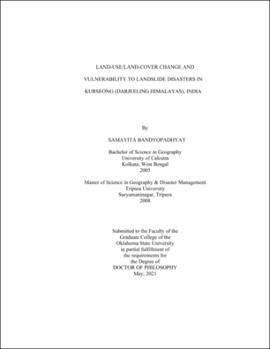| dc.description.abstract | This three-article dissertation (TAD) examines the drivers and impacts of Land-use/land-cover Change (LULCC) on the social-ecological system (SES) in a Himalayan region, prone to landslide disasters. The study region is based in Kurseong, a district subdivision in eastern India, and is home to agrarian communities who work primarily in tea plantations and smallholdings. This dissertation is grounded in integrated theoretical frameworks of Land System Science (LSS), Disaster research and Political Ecology (PE), and employs a mix of remote sensing, archival and ethnographic research methods. Article one identifies LULCC subjected to landslides over the last three decades (1988 - 2019), and explores the proximate and underlying drivers behind local land-use practices and decisions. Article two computes the multidimensional ways in which local people are vulnerable, by adopting a multidimensional livelihood vulnerability index (MLVI) framework, and explores with a political ecology chain of explanation, why vulnerabilities continue to exist. Article three illustrates farmer adaptations to a postcolonial agricultural system, their vulnerabilities and resilience with limited entitlements and access to resources. The GIS and Remote Sensing analyses show an increase in forest cover from 1988 to 2019 (45 - 54%), and a decrease in total landslide area (225.54 - 162.56 ha) over the same period. However, landslide vulnerabilities intensified in heavily settled and deforested areas, inferring a more complex influence of broad land changes at local levels. The MLVI in selected areas further shows farming communities to be multidimensionally vulnerable in varying degrees to several socio-economic stressors. Finally, a decentralized and decolonized political ecology approach tracks the historical and social roots of local adaptations to infrastructural constraints, limited social and economic capitals, and environmental disasters. Such adaptations to the SES are both sustainable and maladaptive, and is defined by adopting the phrase 'clumsy solutions to wicked problems.' The frameworks employed in this research brings together multiple paradigms to help identify the underlying socio-economic and political drivers behind environmental changes, and complex ramifications of environmental impacts on society. Thus, this study simultaneously contributes to a local geography in the Himalayas, as well as transdisciplinary and integrated research concepts for Global Environmental Change research. | |
